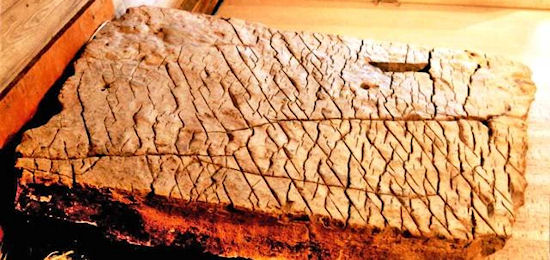It sounds incredible and maybe it is so. On April 2002 a story that defies all standing scientific knowledge about the prehistoric era, became known.
According to a Pravda article in 1999, a group of scientists from the Bashkir University, discovered, near a village of the Urals, a piece of rock sizing 148x106x16 cm and bearing strange marks.
The group was under professor Chuvyrov who has a PhD degree in physics and mathematics. After studying the rock they concluded that the carvings were no less than a 3 dimensional map. The region presented on the map was recognized to be the area around Bashkiria with the addition of several artificial looking dams and canals that do not exist. The existence of similar rocks was first reported in the 17th and 18th centuries from Russian scientific expeditions and also from professor Schmidt in the early 20th century.
The initial tests to determine the age of the finding, using radioactive carbon, indicated that the stone was carved at approx. 3.000 BC. Another indication was derived from two cells found on the surface. The indirect dating produced by these cells resulted at no less than 120.000.000 years ago.
The analysis of the geological structure of the rock slab was indicated that it consists of three levels. The base is 14 cm chick, made of the firmest dolomite. The second level is probably the most interesting, made of diopside glass. Actually, the map is marked on this level and the research team under professor Chuvyrov claims that an x-ray analysis showed that the map carving was probably done with high-precision tools and not by hand. The third level is 2 mm thick and made of calcium porcelain, protecting the map from external impact.
It is also mentioned that the Center of Historical Cartography in Wisconsin, USA, after studying the finding’s details, expressed the opinion that the production of the map could be possible only with the use of aerial and orbital pictures and data. A similar program is under way I the US and is expected to produce results after 2010.
The story was presented in 2 Russian publications and then reproduced in several web sites. In all these cases it was more or less the same text, and the magazine ITOGI is mentioned as the original source. It was not possible to positively crosscheck the story since all relevant articles were almost identical.
Besides the truly sensational essence of the story, its presentation and documentation seems strange and creates a feeling that something is wrong. The skepticism is based on a series of questions. For example, why does an expedition like the one that produced the finding was headed by a distinguished, no doubt, scientist, but still a physist and mathematician and not a geologist or an archaeologist? And of course the lack of several, independent references to such an important discovery (with the reservation that they may have not been noticed) is also a matter of serious concern.




